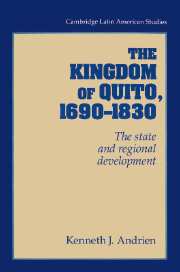Book contents
- Frontmatter
- Contents
- Acknowledgments
- Introduction
- PART I THE STATE AND SOCIOECONOMIC DEVELOPMENT
- 1 The late seventeenth-century crises
- 2 The people and markets of the kingdom
- 3 The state and manufacturing
- 4 Spanish agriculture and the rural economy
- 5 Amerindians and the market economy
- 6 Commerce and economic patterns
- PART II REFORM AND POLITICAL CONFLICT
- Appendixes
- Glossary
- Bibliography
- Index
2 - The people and markets of the kingdom
from PART I - THE STATE AND SOCIOECONOMIC DEVELOPMENT
Published online by Cambridge University Press: 29 September 2009
- Frontmatter
- Contents
- Acknowledgments
- Introduction
- PART I THE STATE AND SOCIOECONOMIC DEVELOPMENT
- 1 The late seventeenth-century crises
- 2 The people and markets of the kingdom
- 3 The state and manufacturing
- 4 Spanish agriculture and the rural economy
- 5 Amerindians and the market economy
- 6 Commerce and economic patterns
- PART II REFORM AND POLITICAL CONFLICT
- Appendixes
- Glossary
- Bibliography
- Index
Summary
The decline of the obraje sector had a profound demographic and economic impact in the Kingdom of Quito between 1690 and 1830. Many Andeans had left their traditional ethnic communities by the seventeenth century to work in Spanish obrajes, on baciendas, and in the chief cities. As manufacturing in the north-central sierra declined, however, increasing numbers of indigenous people lost their jobs and migrated from the north-central highlands to regions promising greater economic opportunities in the south sierra and later the coast. From the 1690s the province of Cuenca benefitted from this influx of Amerindians to develop an economy providing textiles and foodstuffs for regional markets. Entrepreneurs in the southern region also profited from exports to Europe of cascarilla, a tree bark rich in quinine for medicines. The province of Guayaquil began attracting emigrants later in the eighteenth century, when the export of cacao, tobacco, and coffee led to a coastal economic boom.
State policies often influenced the direction of these important structural changes in the kingdom's market economy. By ending nearly two centuries of commercial protectionism, the crown effectively undermined manufacturing in Quito and the entire north-central highlands, which lessened employment opportunities and prompted the out-migration of many Amerindians. Even Cuenca and Guayaquil, which presided over a vibrant network of regional commercial exchanges, still had their economic development influenced by outside political and economic forces. Crown subsidies for mining in Peru indirectly helped provide the market for Cuenca's textiles, and the advent of imperial free trade (between 1778 and 1789) promoted the coastal export economy.
- Type
- Chapter
- Information
- The Kingdom of Quito, 1690–1830The State and Regional Development, pp. 33 - 54Publisher: Cambridge University PressPrint publication year: 1995



